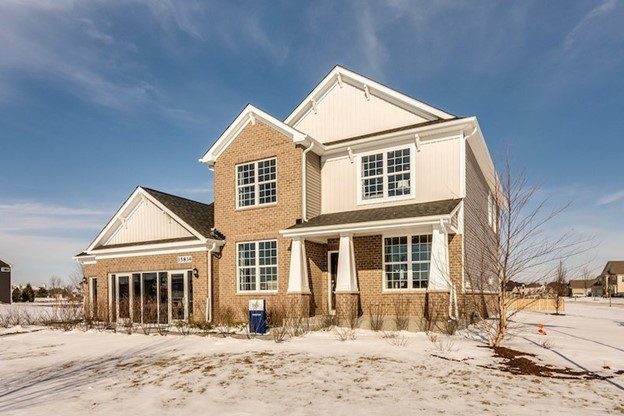New-home sales have surged in each of the past two years in the Chicago area, despite prices that have also been rising fast.
Dennis Rodkin
Crain’s Chicago Business
February 10, 2022

This newly built four-bedroom house on Sargent Drive in Naperville’s Wagner Farms subdivision sold for just under $677,000 in December.
Jolted out of a decade-long doldrums by a housing boom the pandemic ignited, Chicago-area builders sold more newly built homes last year than in any year since 2008.
That’s despite considerable price increases, said Erik Doersching, executive vice president of Tracy Cross & Associates, a Schaumburg-based consultancy that tracks new-home sales.
“A year ago, the typical new single-family home was in the mid-$350,000s” in the Chicago area, Doersching said. “Now it’s approaching $425,000, and incomes did not increase proportionately.” That increase, about 19%, is bigger than the market overall, including both existing and new homes. In the Chicago area, the median price of all homes sold in 2021 was up almost 12% from the year before.
The new-home market is yet another example of buyers, fueled by low interest rates and pandemic-driven desire for bigger spaces, spending up to get what they want, a phenomenon that’s also playing out in the upper-priced mansion market and other housing sectors.
Developers sold 5,477 new houses, townhouses and condos in the Chicago area in 2021, according to year-end data from Doersching’s firm. It’s the first time sales crossed the 5,000 mark since 2008, when sales were over 6,300.
A key difference is that the 2008 figure was on its way down from a years-long stretch of sales totals over 25,000, while the 2021 figure is a new high after a stagnant decade.
It’s the second new high in two years: In 2021, new home sales were up 9.7% from 2020, which itself saw an increase of 17.1% from 2019.
In the early stretches of the pandemic, there was a built-in cap on new-home sales: a lack of inventory because sales had been so low for over a decade that builders cut back on starting new projects. The lag of about 18 months between launch and delivery of new homes, Doersching has said several times in the past two years, hurt builders’ ability to respond to the quick upturn in housing demand.
Since the pandemic and low interest rates ignited a fiery housing market, builders “have a sense of urgency” about creating new inventory, Doersching said. In the Chicago area, they opened 55 new subdivisions in 2021. “That’s the most we’ve seen in quite a while,” he said.
Those developments that were prepared with inventory when the boom hit fared well. Wagner Farms, a development of over 300 homes that national building firm Pulte got rolling in 2018, arrived in time to be 2021’s biggest seller of new homes. Pulte sold 150 homes there in 2021, according to the Cross report. Pulte officials did not respond to a request for comment.
Builders added 40% more new units to the pipeline in 2021 than the year before, according to the Cross report. Much of this may show up as further sales growth in 2022.
The Cross data captures only homes sold in developments of 10 or more, and covers both detached houses and attached condominiums and townhouses. Homes built on individual lots, a popular model in the city, do not get counted.
The second year of the pandemic, 2021, brought the city’s housing market a strong recovery from the walloping it took in the first year of the pandemic, during shutdowns and an increased interest in the suburbs. New-home sales in the city were up nearly 85% in 2021, more than compensating for the previous year’s drop to the lowest sales figure in 25 years. Cross counted 467 sales in the city, well above not only 2020’s count of 253, but also 2019’s count of 386.
Prices are going up in part because demand outpaces supply as well as because of increases in the cost of materials. In August, a builder told Crain’s that even though he had bumped his homes’ prices up a couple of times, his margins hadn’t gone up. “My costs have been going up faster than my prices, Jeff Benach, principal of Chicago-based Lexington Homes, said at the time.
Doersching said fast-rising prices resulted in a shift in buyer preferences, from detached houses to townhouses, which are generally less expensive. Sales of new attached homes, which include townhouses and condominiums, were up nearly 30% in 2021, while sales of new single-family homes were down about 2%.
“Townhomes became a much bigger part of the market,” Doersching said. The share of new-home sales that were attached homes in 2020 was 36%. In 2022, that rose to 42%.
